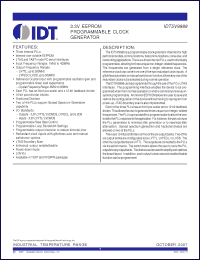|
|

|
|
| Partname: | IDT5V9888PFGI |
| Description: | 3.3V EEPROM PROGRAMMABLE CLOCK GENERATOR |
| Manufacturer: | Integrated Device Technology |
| Datasheet: | PDF (339K).
Click here to download *) |
The IDT5V9888 is a programmable clock generator intended for high performance data-communications, telecommunications, consumer, and networking applications. There are three internal PLLs, each individually programmable, allowing for three unique non-integer-related frequencies. The frequencies are generated from a single reference clock. The reference clock can come from one of the two redundant clock inputs. A glitchless automatic or manual switchover function allows any one of the redundant clocks to be selected during normal operation. The IDT5V9888 can be programmed through the use of the I2C or JTAG interfaces. The programming interface enables the device to be programmed when it is in normal operation or what is commonly known as insystem programmable. An internal EEPROM allows the user to save and restore the configuration of the device without having to reprogram it on power-up. JTAG boundary scan is also implemented. Each of the three PLLs has an 8-bit pre-scaler and a 12-bit feedback divider. This allows the user to generate three unique non-integer-related frequencies. The PLL loop bandwidth is programmable to allow the user to tailor the PLL response to the application. For instance, the user can tune the PLL parameters to minimize jitter generation or to maximize jitter attenuation. Spread spectrum generation and fractional divides are allowed on two of the PLLs. |
|

Click here to download IDT5V9888PFGI Datasheet*) |
 |
| *)Datasheets downloading from ChipDocs is only for our members (paid service). REGISTER NOW for your membership. |
|
|
|

